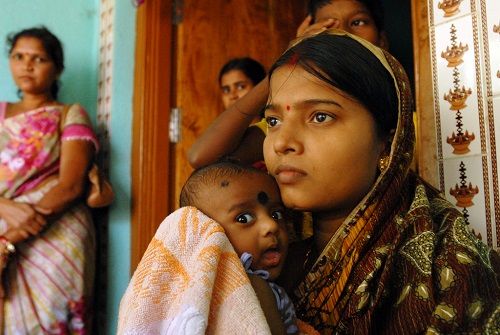Pippa Ranger/DFID photo
By
Neha Mehrotra
As far as medicines went, he had two kinds of liquid- one white and the other red. Beginning with cold, fever, headache, stomach ache, dysentery to typhoid, tuberculosis, cholera, and jaundice, every disease would be prescribed the white liquid diluted in water, to be taken thrice daily. And for cuts, bruises, burns, was the red medicine, to be taken twice daily.
If the patients had recovered with the white or the red medicine, what would have perished was the science of medicine, built up with labour and care over thousands of years by thousands of concerned individuals. All these medical ‘degreed’ doctors, their institutions, the expensive, indigenous or imported medicines-all these machinery, laboratories would be rendered fraudulent and irrelevant. So the patients died. They died with the assurance that they were not dying without treatment. Their deaths were despite medical help from an MBBS doctor.
An excerpt from Interrogating my Chandal Life: An Autobiography of a Dalit by Manoranjan Byapari, this passage describes healthcare in a refugee camp in West Bengal at the time of partition.
A lot has changed since partition. India has largely recovered from the volatility of those times, leading to a general rise in socio-economic conditions culminating in stability. But what has not undergone much of a change is the healthcare in our country which, even now, remains abysmal.
India’s healthcare policy envisages a three tier structure comprising primary, secondary and tertiary health care facilities to ensure people of the country are well ‘cared’ for. The primary tier comprises the most basic forms of healthcare, namely, a Sub-Center (SC) for areas with a population of 3,000-5,000, a Primary Health Center (PHC) for areas with a population of 20,000-30,000 and a Community Health Center (CHC), which acts as a referral center for every four PHC’s, in turn covering a population of 80,000-1.2 lakhs. District hospitals function as the secondary tier of the healthcare system and the last tier, i.e., tertiary healthcare, comprises institutions in urban areas that are well equipped with diagnostic and investigative facilities.
A majority of the population relies on the primary tier of the healthcare system for access to basic medical facilities and therefore, the success or failure of public healthcare in India more or less hinges on the proper functioning of the primary tier.
In March, I visited Bhinga town, the capital of Shravasti, a district in present day Uttar Pradesh. Shravasti, located in north-eastern Uttar Pradesh, incidentally very close to the Nepal border, is steeped in the Buddhist historical imagination. The town is closely associated with the life of Gautam Buddha, who is said to have spent 24 chaturmases (in the hindu calender, a holy period of four months from July to October) here. Scattered across the district are age old stupas, viharas and Buddhist temples which establish Buddha’s association with Shravasti.
Ironically, the district, once home to one of the greatest physicians of the time—Buddha was trained in Ayurvedic medicine and in his own words, “prescribed the right medicine for each person at that time”—is now a healthcare nightmare.
It is one of the most socially and economically ‘backward’ districts in India, receiving Backward Regions Grants Fund from the government. With an excessively high infant mortality rate of 96%, the region saw a negative population growth of -5.25% over the decade 2001-2011. So the question seems to be, what are the healthcare providers in Shravasti doing, or rather, what are they doing wrong?
Visiting the CHC at Bhinga town—the capital of Shravasti—seemed like the first step to answering the question. Interestingly, Bhinga, the most populous town in the district, has a majority Muslim population of 56%, very rare for a country where Hindus form a majority.
Community Healthcare Centers, part of the primary tier of rural healthcare institutions, are required to act mainly as referral centers for neighbouring PHC’s. A place where patients are sent when they require specialised healthcare services, CHC’s ease the burden on district hospitals by ensuring that specialised medical services are available to inhabitants of rural areas in their vicinity.
They are accordingly designed to be equipped with the following: four specialists in the areas of medicine, surgery, pediatrics and gynaecology, thirty beds for indoor patients, an operation theater, labour room, X-ray machine, pathological laboratory, standby generator and last but not least, complementary medical and para medical staff.
At the CHC in Bhinga town in Shravasti, the medical staff comprises two MBBS doctors, five nurses and one daai (a traditional birth attendant, i.e., TBA, who remains the main healthcare provider during pregnancy and childbirth across much of rural India). There is no specialist at the facility. No medicine specialist. No surgery specialist. No pediatrics and gynaecology specialist.
Moreover, one out of the two MBBS doctors was appointed to the facility a mere month ago, until which time the CHC was being manned by one doctor alone.
The newly appointed doctor, Dr. Tahir, hails from Lucknow, the capital city of Uttar Pradesh and incidentally, one of the largest cities within the state. Dr. Tahir is not native to Bhinga town; he lives here in a temporary capacity, even as his family continues to be based out of Lucknow.
“The facilities are better in Lucknow. The schools are more comprehensive. I would prefer it if my children stayed in Lucknow rather than them coming here”, he says. When asked how he was adjusting to his new place of work, he said he was adjusting well enough but that things would be easier if he were native to the place. “I’m not used to rural areas. I come from a city and that is where I’m most comfortable. Here, it’s sometimes hard to understand what the patients are saying.
If one comes from a city, adjusting to life in a rural area can be challenging. One is used to so many luxuries that are not available here. But it’s okay. It is part of the job, and after my rural requirement is done, I hope to be posted back to Lucknow” he says.
Dr. Tahir’s story is not unique. Most doctors have no wish to be posted in rural healthcare facilities, preferring the luxury of cities to the austerity of rural life. This is one of the main reasons for a shortage of doctors in PHC’s and CHC’s across the country: the positions are vacant and the government is continually advertising the job openings, but there are no takers.
This leads to a shortage of doctors, in turn burdening the few who do decide to work in these areas.
At the CHC in Bhinga town, the two doctors barely manage to hold the fort. There is a long waiting line, usually 1-2 hours, before a patient is granted a brief 2 minutes inside the doctor’s office. After a cursory examination—there is no time for anything more thorough—the doctor jots down the names of a few medicines on a slip of paper and hands it over to the patient, before moving on to the next person in line.
The two doctors, cordoned off inside their respective offices, handle the benign medical cases, i.e., headache, diarrhea, stomach ache, fever. On the other hand, the technically and surgically advanced cases, i.e., deliveries, complications during birth, miscarriages, seem to fall to the lot of the nurses. From what I observed at the CHC, the doctors are in charge of the waiting area, where patients come for routine check ups, while the labour room, the operation theater and the delivery room are the domain of the five nurses and the daai, who are perpetually scuttling from one delivery to the next.
This system, where medical practitioners with the most expertise, i.e., doctors, handle cases which need the least expertise, seems counterintuitive. Moreover, it results in nurses having to manage complex medical procedures for which they have no training. This, in turn, seriously compromises the quality of medical treatment patients receive.
For instance, one woman was brought in with blood running down her legs. After being made to wait for 30 minutes, she was finally examined by one of the nurses, who told her that she had had a miscarriage. On asking the nurse the reason for the miscarriage, she shrugged. “She must have eaten some medicine she’s not supposed to. These people eat a lot of things and sometimes, it affects the baby”, she said, almost casually.
Another shocking instance of medical negligence was a woman who went into labour while lying on a bench in the waiting room. She lay there for almost 15 minutes before anyone noticed that her water had broken. Subsequently, a nurse came and told her someone would be with her in just a while. It was another 15 minutes before another nurse came and wheeled her into the labour room.
There is obviously something that needs to change in the way healthcare is administered in PHC’s and CHC’s like this one across the country. But what change are we talking about and who is to blame?
It’s not like the doctors are not doing their jobs. They are present at the medical facility throughout the day, coming in even when they’re not officially on duty. Nurses are working 24 hours a day, most days not even going home at nights. But in spite of this, patients really in need of medical assistance are not getting any. Women are giving birth on the floor and babies are dying.
Dr. Satya, the second of the two MBBS doctors at the CHC in Bhinga town, is a local. He has no problem working in rural areas since he was born and brought up here. “I understand the language and I understand the people because I am from here. That’s why I have no problems.
It’s easier for me to adjust. In fact, I would prefer to be posted in a rural area than in an urban area”, he says.
This seems to provide an inkling of a solution to the problem. Instead of recruiting doctors from urban areas for rural job openings, graduates from rural areas itself should be offered job positions in the locality. This would ensure that the openings are filled sooner and by people who are actually comfortable living and working in rural settings. Additionally, doctors would then stay at rural facilities for longer periods, instead of the required minimum of two years, leading to a stable consistency in regional healthcare.
Another major change that needs implementation is better division of labour within the confines of the CHC. Cases ought to be handled according to varying degrees of expertise. Serious cases should be dealt with by the doctors, while nurses should stick to routine cases that do not require exertion beyond their expertise. A healthy communication between doctor and nurse would be a useful first step in ensuring a balanced division of labour, a communication that, as of now, is almost non-existent.
These are merely a few preliminary steps to raise the level of primary healthcare provided in rural areas. Healthcare shouldn’t be reduced to what it was in the refugee camps at the time of partition: namely, people dying but dying with the assurance that they are not dying without medical treatment.
Neha Mehrotra
I am a third year undergraduate student at Ashoka University, India, majoring in English and Journalism. As of now, I don’t know what I like more, literature or the media but I’m hoping to figure it out soon. Until then, I’ll try my best to keep dabbling in both.



A Great Analytical report.